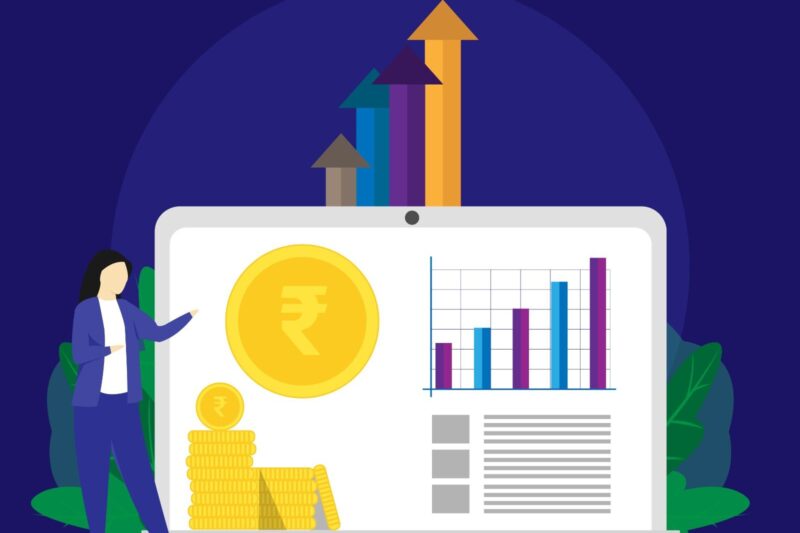Investing is similar to balancing a slippery slope: you want to achieve your financial objectives while avoiding unnecessary losses. The idea of risk versus return is relevant here. Whether you’re building wealth, saving for a home, or retiring, knowing it can help you make better investment decisions. Maintain a good Credit Score to improve your financial stability and borrowing power.
Here, we will be discussing how to make your money work for you without taking needless risks, offering helpful strategies, and examining how to balance risk and return in investments.
What is Risk vs Return?
Simply speaking, risk versus return refers to the relationship between what can be gained from an investment and the level of risk involved.
Risk is the potential for financial loss or failure to generate the expected profits. And the gain or profit you receive from your investment is known as return.
Higher return investments generally seem riskier. On the other hand, safer investments typically result in lower returns. The difficulty lies in finding the right balance between your comfort level, time horizon, and financial objectives.
Why Balancing Risk and Return Matters
Risk and return must be balanced because they benefit you in the following ways:
- Protect Your Money, stay clear of investments that carry too much risk to avoid suffering large losses that could throw your financial plans away.
- Safely Increase Returns. You can generate acceptable returns without taking on too much risk by carefully balancing your investments.
- Maintain Your Commitment to Long-Term Objectives. During crises in the markets, emotional investing frequently results in anxious buying and selling. A thorough investment plan encourages disciplined investing and reduces stress.
Step 1: Assess Your Risk Tolerance
Consider your degree of comfort with risk before investing.
- In exchange for a chance of greater returns, are you willing to let the value of your investments shift over time?
- If your investment lost 10% in a month, would you panic?
- Do you have emergency savings to cover unexpected costs and a steady source of income?
Your responses will figure out the right degree of risk. While those approaching old age could prefer safer investments, younger investors with longer periods to invest may be able to accept higher risks.
Step 2: Define Your Investment Goals
It is easy to balance risk and return when you are aware of what you want from your money. For example:
- Low-risk investments, such as money market funds or fixed deposits, are necessary for short-term objectives.
- Bonds and investments in stocks can be used to achieve medium-term objectives, such as saving for a home or college.
- You can take on greater risk with stocks, mutual funds for stocks, or real estate if your long-term objectives are met. Get easy access to funds with an Instant Personal Loan to meet your financial needs.
Setting specific objectives guarantees that the investments you make match with your expected returns and level of risk tolerance.
Step 3: Diversify Your Portfolio
Portfolio diversification is one of the best methods to control risk while chasing returns.
Diversification means splitting your funds among several kinds of assets, including:
- Stocks, or shares, are investments with a high return potential but also a high risk.
- Bonds are investments with lower risk and consistent returns.
- Real estate can yield both rental income and long-term growth.
- You can protect yourself from rising prices by investing in gold, silver, and other commodities.
Combining such investments lowers the overall risk of the portfolio by allowing improvements in one area to cover poor performance in another.
Step 4: Understand the Risk-Return Spectrum
Knowing different kinds of investments fall in the risk vs return range is crucial.
- Government bonds, savings accounts, and fixed deposits have low risk and low return.
- Moderate Risk, Moderate Return on Index funds and balanced mutual funds
- High Risk, High Return on Startups, Cryptocurrency, and Individual Stocks
By selecting investments from this range based on your goals and tolerance for risk, you can build a balanced portfolio that increases gradually without exposing you to undue risk.
Step 5: Monitor and Adjust Your Portfolio
Finding the right balance between risk and return is a continuous process. Goals change, markets shift, and your financial situation may also change. Frequent monitoring benefits you:
- To maintain the desired asset allocation, adjust your portfolio.
- Reinvest in investments that are failing after taking profits from high-performing ones.
- If your risk tolerance shifts, reduce your involvement in risky assets.
Maintaining your portfolio’s consistency with your long-term goals requires a systematic strategy.
Step 6: Use Professional Advice if Needed
Think about speaking with a financial advisor if you’re not sure how to proceed with your investments.
Advisors can:
- Help with identifying your level of tolerance for risk
- Offer suitable investment options.
- Allow us to find a balance between risk and return according to your financial objectives.
Beginners and those in charge of huge portfolios are going to benefit from this support.
Tips to Maintain a Healthy Risk vs Return Balance
- Start small. As your confidence grows, gradually raise your participation in investments that carry low to average risk.
- Follow your plan. Avoid emotionally responding to changes in the market.
- Become educated about market trends, economic factors, and various investment options.
- Keep an emergency fund because money on hand enables you to continue investing without having to make quick withdrawals.
- Review objectives regularly. Your investment strategy may need to be changed as your life situations change.
Conclusion
The secret to wise investing is finding a balance between risk vs return. If you need quick funds to manage short-term goals, explore our Quick Loan options. You can gradually increase your wealth while monitoring risks by understanding your objectives, investing carefully and regularly reviewing your portfolio.




